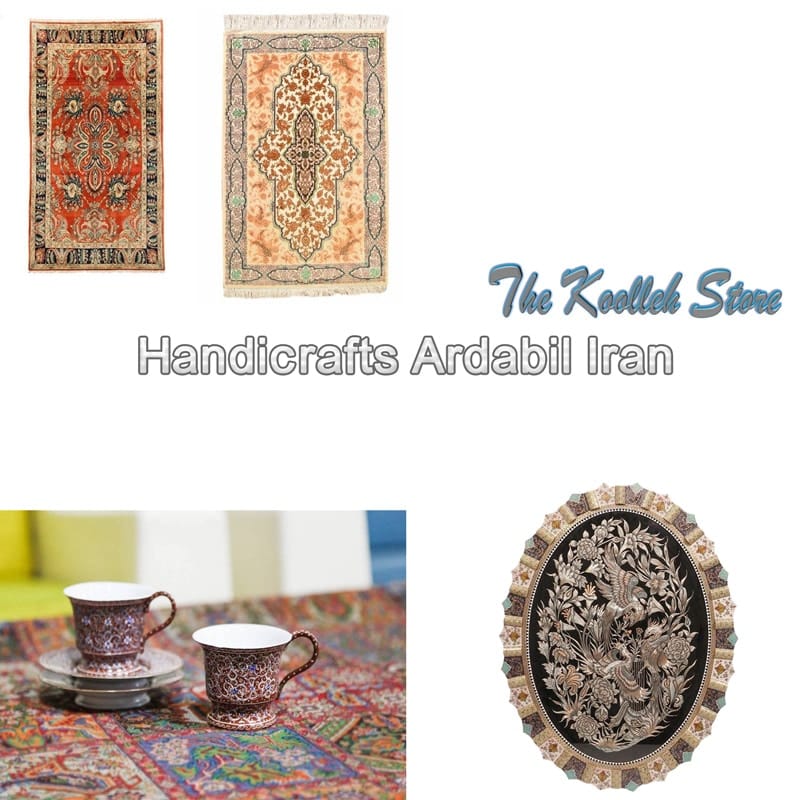Handicrafts Ardabil Iran

Lovely and attractive handicrafts in Ardebil are produced by the villagers and nomads of the region, and most of these products are made from natural raw materials and sell them to drive the economy of these families. It is interesting to know that the woven and woven fabrics of these handicrafts are exported to other countries and are very popular.
Carpet weaving
Carpet weaving is one of the most important handicrafts of Ardabil which is world famous and its ancient examples belong to Parthian period. The main designs used in this film are the roles of dragons, seals, crabs and samovar trays, and are used most in Namin, Moghan and the surrounding villages.
Ardebili artists weave the carpets in three simple types of weaving, prominent and varnished.
Jajim weaving
Jajim Weaving is another handicraft of Ardebil province that is widespread among the Khalkhal people and other villagers in the area. Jajim embroidery is simple and floral, and Jajim weave artists use it to make a prostrate, upholstery, toilet, seatback, backrest, sofa and bag.
Jajim is usually about 90 to 120 cm in size and you can see beautiful examples of it in traditional Ardabil markets.
Rug weaving
The carpet weaving dates back to the 16th century. It is interesting to know that one of the most exquisite carpets in the world is Ardabil carpet design and texture. The carpets are simple, symmetrical, and are woven from silk. The texture of this type of rug uses Turkish knots and designs such as Mashayekhi, bergamot, Herat, pot and dwarf.
Plus weaving
Plus weaving has flourished in different regions of Ardebil and most of the tribes in the past and is very similar in appearance and texture to the glim. Plus, cotton and wool are used to make the plus, and if you go to Ardebil markets you can see the beauty of this art in tools such as underwear, skirts, bow ties and bags.
Weaving bags
Knitwear is one of the old Ardebili handicrafts whose texture and dimensions resemble that of carpet and varnish and its raw materials are rug and varnish. A mirror or bag is a traditional handbag, which is made of two rectangular rugs measuring 30 to 40 centimeters in length, using a cracker to slice it from three sides and open the other. they let.
Cooker oven
In the local language, a stove means a kind of stove shield. This wool weaving cloth is used to care for carpets or floors against oven flames and its production is prevalent among the tribes of Moghan Plain. The oven is similar to the Jajim in terms of texture and appearance and uses geometric and experimental patterns to weave it.
Weaving skirts
The sachet is a large, double-woven bag that is used to place the back of a motorcycle, bike and some cattle. The art of weaving sash among the tribes of Ardebil, especially the Shahsun tribes, is well developed and is used to produce jajim or plus.
The width of this widely used product is between 30 and 90 cm and, as one can guess, its ingredients are indigenous and woven from colored wool, goat hair and cotton yarn. Ardebil vases between villages are known for their quality and beauty.
Weaving chair
The seat is a kind of ornamental carpet woven from roles such as hunting grounds, pots, tripods, garages and bergamot. Plants are used to correct the color of powders. Residents of Namin and Khalkhal are known for their prominent role in the production of seat belts and are exported to European countries such as Germany.
Weaving salt
Woven saltcake is similar to a bag used to carry and store eroded and coarse salt stones and is common among Ardabil tribes. The salt-like texture is similar to Jajim and Gliem and is sewn in a cylindrical shape. The roles used in salting weaving are designs of plants and animals inspired by nature. The artists use linseed as a primer to insert the salt into the salt so that the wool does not touch the wool.
Pottery
Pottery is one of the oldest human-made handicrafts dating back to the Parthian period and before. Ardebili potteries use clay, which has a low purity and high adhesion, and, with the help of their artist hands, make it into forms such as mugs, jars, statues and bowls.
The pottery is placed in the oven after shaping and their natural color changes from pea to red. The finished product is cooked and glazed and has many uses.
Seraji
Seraji is one of Ardebil’s handicrafts, which is called the art of making saddles with leather. These fine handmade products made from tanned leather are also popular in Azerbaijan. The person who puts the saddle on the horse or the artist who makes the saddle is called Seraj. These saddles have their own fans in the country and are considered a luxury device.
Woodturning
Woodturning is an art in which the wood is scraped using a circular motion and shaped by scratches and bumps. At Woodturning, the harder and firmer the wood is, the finer the product is.
Ardebili Woodturning artists make use of walnut wood, ash, elm and alder such as cane, timber, hookah, furniture, table, lampshade and chairs. If you are interested in these handmade items you can buy them from the city markets.
Tapestry
Tapestry is one of Ardabil’s handicrafts and is called the art of making ornaments, pots and ornaments using metal, wire, gold, silver and copper. The remains of this art show that it is three thousand years old and is one of the oldest ways of making jewelry.
